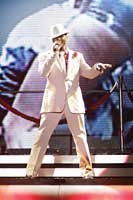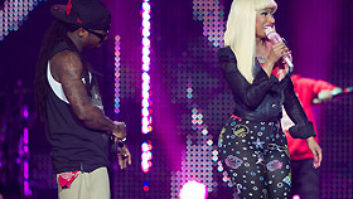
All photos: Steve Jennings
It’s halfway through Usher’s second show at the Oakland Arena (Oakland, Calif.) in early September when front-of-house engineer Horace Ward checks the SIA Smaart Live and moves to adjust the Prism I/O system. “There are just some frequencies that are bugging me,” he explains, “so I’m taking some stuff out.” Considering the rapt attention paid to Usher, Ward might be the only person in the entire venue who notices the offending frequencies.
Yet Ward continues to tinker with the system that only a few hours before he had set while checking it with Sting’s “When We Dance.” The song is not a random pick for Ward. “It’s a very nice, soft, mellow-sounding record with reverb, big low end, a sparkling snare and legible vocals,” he reports. “It’s got everything in there and it’s very cleanly recorded. I always use that song and I drive the crew mad.” [Laughs]
Not only is Ward charged with mixing one of the current top acts in R&B, the FOH engineer must manage the sound of four musicians — drummer Aaron Spears, keyboardist Rudolfo “Valdez” Brantley, guitarist Juan “Johnny” Najera and keyboardist Arthur “Buddy” Strong — who play alongside loops and background vocals triggered via an Akai MPC4000 and Mackie hard drive.
WORKING THE BOARD
What makes these shows a bit easier for Ward is the 80-channel digitally controlled analog ShowCo Showconsole. “The interface that I have out in front looks like a mixing console, [but] it’s actually like a big digital remote control,” he explains. “Under the stage is a huge rack that has all the audio cards, so all the audio comes from the stage, goes into the audio cards and I manipulate it with this control surface.” The console enables him to set up the show so that each song is a scene with an individual mix. “I usually set those scenes and do little manipulations on top of it during the show. The lead vocal is always isolated from the mixes because it varies, depending on the venue. This interfaces with the Prism system through the I/O interface. For me, it’s invaluable.

(L-R): Tim Banas, audio tech; Dave Ski, monitor engineer; John Edmonds, Showconsole “doctor” and audio tech; Paul Jump, crew chief/system engineer; Horace Ward, FOH engineer; and Rob Smuder, monitor tech
“I needed a console that gave me smooth cuts and I use the bandwidth a lot,” he continues. “Instead of going plus or minus, I will narrow a bandwidth and take out a frequency. I use it as a parametric. If you don’t utilize a bandwidth when you’re EQ’ing, you’re not using it right. You have to know what gap within the frequency spectrum you want to get rid of or you want to add.”
Ward has turned to an Avalon AD 2044 compressor and an Apogee 6-band parametric EQ for Usher’s vocals. “But that’s only because I’m using the EQ for the tone of the vocal and using the parametric to get rid of the erroneous sounds that kick back off the stage. I’m using the EQ on the board to shape the vocal,” he says. As for delays, Ward uses a TC Electronic 2290 and a pair of D2s. A TC M5000 multiprocessing unit gets tapped for drum reverb and the Eventide Ultra-Harmonizer DSP 4000 comes in handy to fatten up pre-programmed Usher and background vocals. The main reverb on Usher is TC’s Reverb 6000. A pair of Yamaha SPX-1000s are used for dual-delay guitar effects and a reverse gate on the drums.
As for microphone selection, Usher switches between a Crown CM-311 headset and a Sennheiser handheld with an Evolution body and 935 capsule. Keyboards and acoustic guitar are DI; the guitar amp is miked with Audio-Technica 4055s. The majority of the microphones used on the drum kit are Audio-Technica models, except for a Neumann KSM 1 for the ride cymbal.
FINDING THE RIGHT P.A.
Ward says that the Prism system works best for his arena shows. “This is a system that whatever you get [at FOH], you’ll get all around,” he explains. “The coverage is tremendous. Right now, everybody is line array — oriented and I love some of the line array systems, but for me, it lacks coverage once you get past 180 degrees. I can get 270-degree seamless coverage now.” Likewise, the Prism system enables him to hang more cabinets per side — 40 on this tour — than he could with a line array system. Ward has the Prism II subs out with him.
Ward explains that the Prism is an older system that’s been revamped. “It’s still a workhorse,” he says, “and it’s been out for a while, but you could put it alongside a lot of systems that are five years old and it sounds just as good. When I set up a system, I go from the crossovers up. I balance the system out. Most engineers could work this system flat, others like to pick and poke with EQs. I could [fine-tune with EQs] all day and still have a lot of power.” The system is powered by 60 Crown Macro-Tech 3600VZs.

MONITOR WORLD
Monitor engineer Dave “Ski” Lagodzinski jumped on the tour’s U.S. leg after working with Justin Timberlake. This tour offers him a number of challenges, including that the band is located 10 feet above the main stage and use wedges for monitors, while Usher has Sensaphonics in-ear monitors. Also, Ski had to find the right type of monitor mix. “The R&B thing is a little different than the regular full pop show because there’s a lot more feel and emotion going on.”
“It’s a really dynamic show so when you mix the slow stuff, you’ve really got to ease things in,” Ski explains. “It’s almost like a massaged-in kind of thing. But then there’s the hard, dancier, poppier stuff that you can crank. The dynamics of his vocals are amazing. At the beginning of the song, he’ll almost be at a whisper, and at the end of the song, I’ll be compressing it with everything I’ve got.
“The crowd is part of the show, so I have audience mics up the whole time and I’m riding the audience,” he continues. “Usher can feel their reactions as well as hear them sing along.”
Across stage-front, Ski has laid out eight Clair Bros. 12 AM wedges and has flown sidefills and subs on the deck. On the upper deck, the band is also using the 12 AMs. Ski put Usher’s vocals into two channels “so that I can EQ it for wedges and EQ it separately for ears,” he says. “The biggest thing about mixing ears is consistency. No matter how much the room changes, you have to keep a similar mix nightly. This way, an artist can walk into any room and still feel as comfortable as they did the night before. How they perceive themselves to sound is directly correlated with how they will perform.”
CONTAINING THE NOISE
Obviously, acoustics change when the crowd enters the venue, but for Ward, the sound “steadies itself and it becomes real clean and big. I’m trying to interpret what I see and it’s a huge stage with a lot of things going on with dynamics and we play to crowds that are really loud.” While he pushes up to around 105 dB at FOH, Ward doesn’t believe it’s loud enough to do damage. “I sit through this every day and believe me, I don’t like things that are untoward. I don’t like erroneous frequencies that are edgy, the frequencies that annoy. I’m trying to paint a picture that’s crystal. I’m trying to bring to life whatever is coming off the stage.
“I always make this statement: ‘It’s not just about hearing it, it’s about seeing it.’ As an engineer, I depend on a great lighting guy as much as I depend on me doing my job because I need to see what I’m mixing,” he says. “It’s just one sense helping the other sense. I always tell people that if you go to a concert and you’re sitting far away from the stage and the performers look as if they are really close to you, then the sound is good. The sound helps you get that visual.”
David John Farinella is a San Francisco — based writer.


